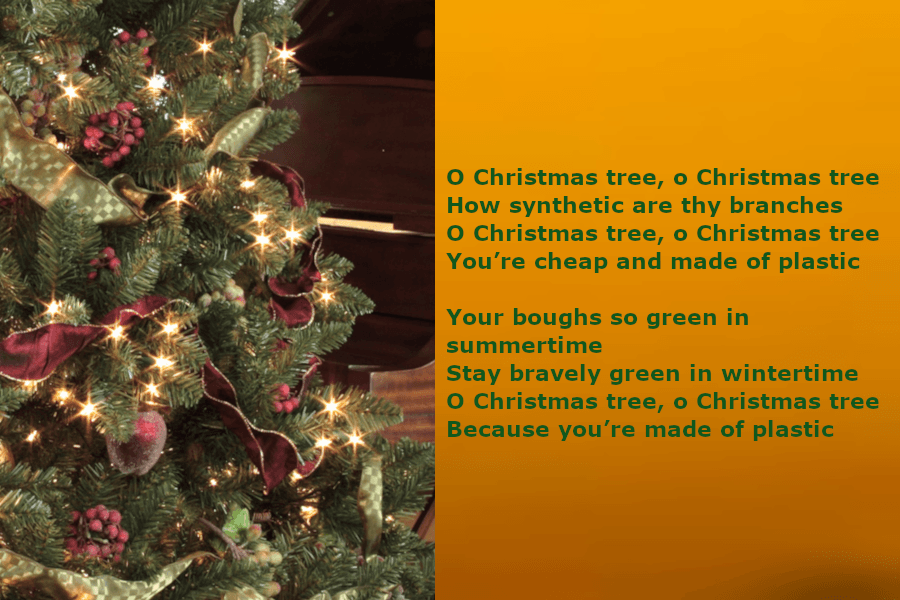by Steve Watson
7 minute read
This Christmas, many festive households will choose between a real Christmas tree and an artificial one. While homemaking considerations may determine the choice for most, the question of whether to go real or fake has an extra dimension for the environmentally minded householder: is one option really better for the environment than the other, and what can be done to minimise the impacts of celebrating Christmas with a tree?
Fir enough?
If you go looking for answers based on lifecycle assessment (LCA), you’ll find two main sources containing quantitative assessments. First, there’s a US report produced by consultancy PE Americas on behalf of the American Christmas Tree Association (which mainly represents artificial tree businesses); second, there’s a statement from the UK’s Carbon Trust (which works with both public and private sector organisations to achieve carbon reductions).
The PE Americas study compares the most commonly purchased natural and artificial trees in the US – a Fraser fir and plastic tree made in China. As is often the case with LCAs, it finds a wide range of results depending on the variables, chief among them being the lifetime of the artificial tree and the end-of-life treatment of the natural tree. However, the general conclusion is that, in terms of global warming potential, the impact of an artificial tree kept and reused for four years ‘breaks even’ against the impact of a real tree used for just one year and then incinerated or composted.
How does the Carbon Trust statement compare? In their view, the artificial tree fares significantly worse, with a carbon footprint more than double that of a landfilled real tree, and more than 10 times that of a real tree planted, chipped or burned at end-of-life. This means you’d need to use the artificial tree for at least 10 years before you’d break even with buying a fresh real tree and composting it each year.
Fake plastic trees
To quote some numbers: the Carbon Trust reports that a 2m artificial tree has a carbon footprint of 40kg CO2eq, while a real tree of the same size has a footprint of 16kg CO2eq if landfilled and 3.5kg if planted, chipped or burned. Landfilling is generally considered the worst end-of-life option for a real tree because methane – a greenhouse gas 25 times more potent than carbon dioxide – is produced as the tree decomposes, and some will escape the landfill site.
However, landfill is an ever less likely fate here in the UK, with special Christmas tree recycling collections becoming widespread and an ongoing move away from landfill for residual waste, and the alternatives (incineration or composting) fare rather better, with composting outperforming incineration to a small degree in the US study. The Carbon Trust (somewhat controversially) assumes the tree should be classed as “short cycle” carbon, and that incineration therefore has no net CO2 emission impact.
So, taking all of the above into account, what is the best arboreal option for the festive environmentalist?
Top of the tree
Both studies suggest that reusing an artificial tree will eventually break even with buying a “single use” real tree every year. However, the studies imply that reusing a real tree is a better option still. Assuming that a potted tree does not have a significantly greater carbon footprint than a cut one, the Carbon Trust’s numbers suggest that reusing a real tree just once would raise the break-even point for artificial trees to 20 years.
As the Carbon Trust says: “the best thing you can do at Christmas is keep a tree alive and breathing”, as this way the tree will keep on absorbing CO2 and releasing oxygen.

Will you spruce things up this Christmas with a real tree? Photo: Mfisherkirshner (CC BY 2.5), via Wikimedia Common
Anecdotal evidence from an informal company survey here at Eunomia suggests that it’s quite easy to reuse a real tree for about five years before it either gets too big or dies (although our MD managed it for over a decade!) You’d have to use an artificial tree for 50 years to break even with this average.
If you are going to reuse a real tree, a good tip is to keep it potted in the garden throughout the year. If you plant it directly into open soil, it’s likely to put down some pretty hefty roots, making it difficult to dig up come December. Also, those with both green principles and green fingers should remember that Christmas trees are essentially baby trees, and could eventually grow to be taller than a house!
Of course, this reuse option is only available to householders with outdoor space. There are, however, alternatives for those without. For example, some companies will rent you a Christmas tree for the holiday period and then take it back to cultivate for the rest of the year – though this option will add some transport emissions to the footprint of your tree. Or, you can seek out alternative reuse solutions, such as donating your tree to a zoo to be used as food by elephants or a toy by lions and tigers – apparently, Christmas trees are just like catnip to big cats!
Christmas tree bill
Given that real trees have the potential to be much better for the environment than artificial trees, it’s worth asking whether their respective retail prices accurately reflect the relative environmental costs.
An artificial tree of around 2m such as we’ve been discussing can be had for a wide range of prices, presumably depending on quality.
- At the cheapest end, B&Q will do you a ‘bargain’ PVC woodland pine for £17.99; at the other end of the spectrum, a realistic PE and PVC Ultra Mountain Pine tree from Christmas Tree World in Wigan will set you back £149.99.
- As for real cut trees, Homebase offers a 6–7 footer for £42, while a premium ‘non-drop’ (as in needles) tree can cost up to around £60 from a local seller.
- A 5ft pot-grown tree, suitable for reuse, can be obtained at prices starting from around £50.
- Renting a tree for a year can cost upwards of £40 per year, and there’s often a refundable deposit to pay.
So, it’s roughly twice as expensive, at the low end, to buy one real tree as it is to buy an artificial one. To cover a 10-year period with one artificial tree, you would spend a minimum of £17.99 and emit 40kg of CO2eq (by the Carbon Trust’s accounting). If you bought a real tree every year for 10 years and then burned or chipped them, it would cost you a minimum of £420 and result in similar emissions. Renting will cost much the same as buying cut trees, while keeping an equivalent pot grown tree will cost around £100, assuming that each lasts five years.
The low cost of artificial trees seems to be a clear example of a failure to account for environmental externalities in the price. Sure, the cheap artificial tree might be reused for 10 years and break even environmentally. However, estimates of an artificial tree’s average lifespan range from four to six years and low prices provide little economic incentive to maximise reuse.
As we’ve explored before here on Isonomia, an important means of internalising environmental costs into market prices is through targeted taxes and levies. With public, media and to some extent government attention currently focussed on single-use plastic items, would it be too Scrooge-like to call for a minimum charge for an artificial Christmas tree to encourage reuse and bring prices into line with more sustainable alternatives?
Carbon footprints in the snow
The PE Americas study for the American Christmas Tree Association concludes that, all things considered, the carbon footprints of both real and artificial trees is negligible within the context of the average person’s lifestyle and total annual carbon footprint. We might add that the environmental impacts are also small within the context of Christmas alone – just think about the combined footprint of the presents under the tree, Christmas travel, or even your Christmas dinner…. The list is as long as your Christmas to-do list.
However, the choice between a real and an artificial tree isn’t just about limiting environmental damage. Choosing a real tree, and choosing to keep that tree alive for as long as possible, can be a way to achieve environmental benefits by taking carbon out of the atmosphere, while providing a year-round feature for a garden. While most Christmas traditions now revolve around increased consumption – with all the associated negative impacts – a living real Christmas tree stands out as something of a Christmas miracle for its ability to deliver year-round environmental benefits. Like a puppy, a Christmas tree isn’t just for Christmas.






Thanks very much for your interesting little blog piece on Christmas trees. Much appreciated! I think the studies you cite, and your commentary are well argued from a carbon sequestration and energy use perspective.
However, I think they omit a very crucial issue about trees and climate change moderation. That is the heat dissipation effects of forests and mesic landscapes, contributing to climate stability.
Two principal processes are in play, one at regional scale and one operating more locally.
At the regional scale forested landscapes contiguous with coastlines are now thought responsible for “pumping” maritime moisture-laden air onto the land through evapotranspirational flux. It appears that complex natural forests with high leaf-area index will deliver the most precipitation via this ‘biotic pump’ mechanism, while sparser savannas will deliver the least. Productive forested landscapes, including those used for sustainable Christmas tree production (!) can be expected to have the potential to also contribute in this way.
A second, and perhaps more far-reaching, implication of forests and other vegetated landscapes for climate moderation is their contribution to dissipation of incoming solar energy through the daily water cycle. This cooling value of vegetated landscapes, until now little acknowledged in mainstream climate science discussions, might even be an equally significant contributor to climate moderation as sequestration of carbon dioxide per se.
I reckon that if these additional climate moderation benefits of trees and tree-growing were included in the analysis, encouraging the use (and replanting) of real trees would win hands down over plastic ones.
Cheers from Australia.
Bill Hurditch